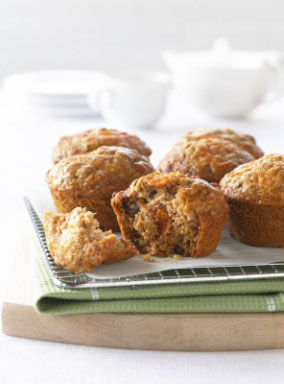Low Fat Persimmon Muffins

Low Fat Persimmon Muffins
Makes 12Ingredients
1 1/2 cups wholemeal plain flour
1 cup plain flour
1/2 cup sultanas
2 teaspoons baking powder
2 teaspoons bicarbonate soda
1/2 teaspoon cinnamon
1 large egg, lightly beaten
1 1/2 tablespoons vegetable oil
3/4 cup honey
1 cup ripe persimmon pulp, mashed
Method:
1.Preheat the oven to 180 C. Grease a 12-hole (1/2 cup capacity) muffin pan.
2.In a large mixing bowl, combine all dry ingredients. In a small bowl combine all wet ingredients.
3.Add wet ingredients to dry ingredients. Gently fold together until just combined. Over-mixing will create a tough muffin.
4.Spoon into muffin pan, bake for 15-18 mins or until the tops bounce back. Serve warm or cooled.

AUSTRALIAN FRESH PERSIMMONS
Fresh Australian sweet persimmons are fast becoming a fashionable choice amongst fruit and vegetable buyers in autumn with the fresh crisp and crunchy delectable taste just pure pleasure. With their versatility in the kitchen and the natural sweet tasting goodness it's not hard to see why they are climbing up the popularity ladder!The adaptability of this bright red-orange, sweet delight in the kitchen makes it an ideal pairing to sweet or savoury, hot and cold dishes, as well as a compliment to many snacks and finger foods.
The astringent variety of persimmons are perfect for a cheap and easy way to make your own sorbet. Make sure the fruit is well ripened, pop in the freezer, then when frozen slice the top off and spoon the frozen pulp right out of the skin - you can sprinkle some lemon or sea salt for added taste!
Don't forget, when selecting persimmons, the fruit should be brightly coloured, glossy and firm. The green calyx (the flower shaped cap) will become easy to remove as the fruit ripens. The appealing exterior hides a surprising centre - a unique star pattern, which is only visible when the fruit is cut horizontally.
They have high levels of vitamins A and C, as well as potassium, phosphorus and beta-carotene. These brightly orange glowing fruits contain virtually no fat - which makes them great snacks, that won't go straight to your hips!
Serving suggestions:
Persimmons are perfect to use as an ingredient, whether in hot, cold, sweet or savoury dishes as the flavour is not over powering making it subtle, sweet and delicious.
Did you know...
MORE



